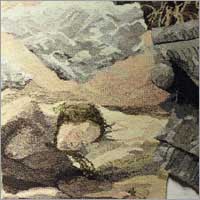|
I am concerned with ideas and questions relating to the landscape and our place in
it. I find myself in the 'guilty' position of thinking of an 'occupied' land as
'home' and at the same time not able to relate to the withering vastness of much of
Australia's countryside. I am a white coastal dweller when the Australian
'mythology' claims that the desert is the source of spiritual enlightenment,
and that the Aboriginal Dreaming holds a special truth which eludes us. My
understanding of the landscape has often been mediated by the experience of
others expressed primarily in history and literature. This is seen by some as a
'second-hand' experience rather than the 'real thing'. To explore this idea
further, I have been looking at the landscape through connections between visual
art representation and other forms of cultural expression in my work over the last
few years.
It is hard for us to envisage a world without language. The power of the word,
arising in the West from the Christian logos is paramount. Also, the Western
tradition suggests to us that there are pure forms of cultural expression.
Intensely visual images emanate from all kinds of situations: memories, dreams,
fantasies, fleeting glimpses, imaginings. While many of these are not in fact
actual, they nevertheless represent a form of 'truth' and / or 'reality' in that
our eyes have 'seen' them. And it is a short step to apply powers of persuasion
based on these supposed truths. This is the space occupied by the Explorer who
finds only what he can recognise from his previous experience.
It is this in-between-ness in all its ordinariness and mystery which is our human
position. We live at the intersections of places, between the past and the future,
the earth and the sky, and this is not a no-man's land, but a means of connection.
Meaning is found in many ways - where one perceives a connection, a possible
connection, a lack of connection, or even the ghost of a former connection.
|


